Posted: Feb 07, 2016 6:36 pm
Here are some examples of using the entropy space counter-factuals to define some different regions of entropy space.
Four regions in space, each with different densities would be defined like:
lentropy=[
[ [.5, 2., 10, 20, cry, 'r'], [.5, 1., 10, 20, cry, 'r'], [0., 1., 3, 20, cry, 'r'] ],
[ [.5, 2., 5, 20, cry, ''], [2.5,4., 10, 20, cry, 'r'], [0., 1., 2, 20, cry, 'r'] ],
[ [3., 4., 2, 20, cry, 'r'], [.5, 2., 2, 20, cry, 'r'], [0., 3., 2, 20, cry, 'r'] ],
[ [3., 4., 20, 30, cry, 'r'], [2.5, 4., 20, 20, cry, 'r'], [0., 4., 15, 20, cry, 'r'] ]
]
Each line defines a different region. Each list on a line is for pitch, rhythm, and vertical entropy.
Each list defines min entropy, max entropy, min density, max density, crystal factor, and shape.
The above would produce a space similar (I think I changed a few variables a bit) to this: (At this point I'm calling a uniform random number generator to find objects to attempt to fill the regions, eventually I'll try to fill the regions with licks.)
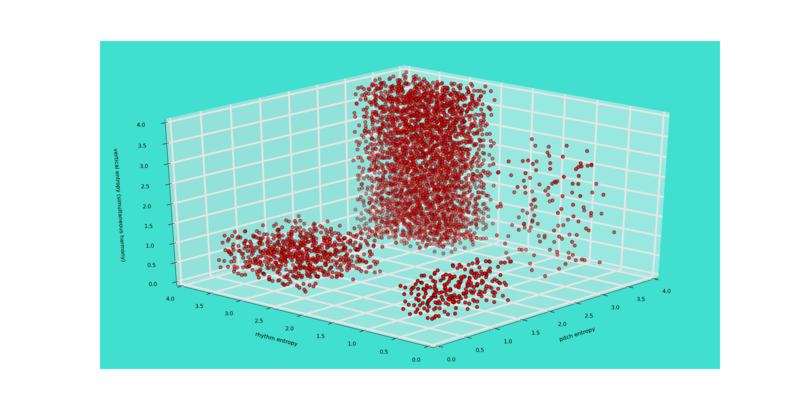
And by changing the shape variable, wedges and triangular shapes can be specified. I added this mostly to accomidate sweet and sour possible profiles, I'll add other shapes if there seems to be a need for them.
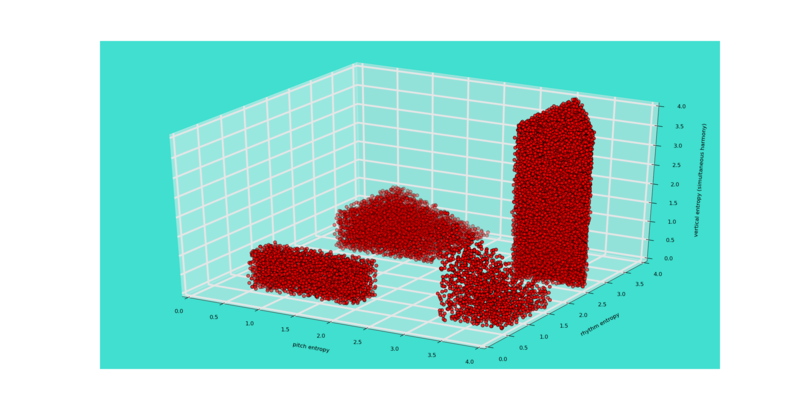
By adjusting the density and crystal factor more or less regular lattice spacing can be specified. I'm not sure how useful this is, it's just something that came to mind as I was trying to think about the problem of selecting licks (or random anything) to fit a volume and how one might go about doing that.)
Pretty regular.
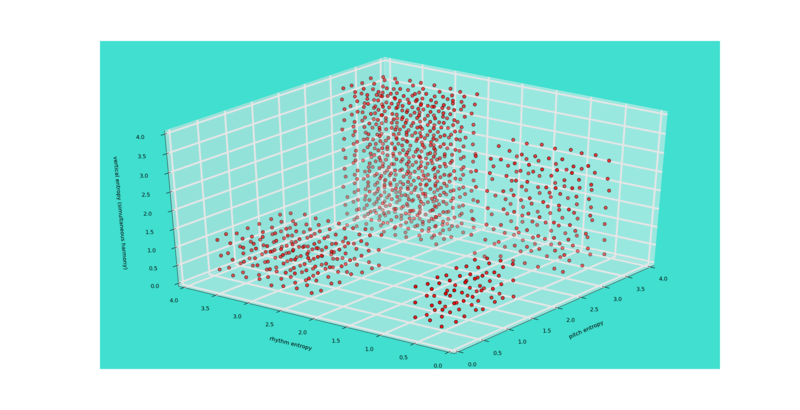
And more regular.
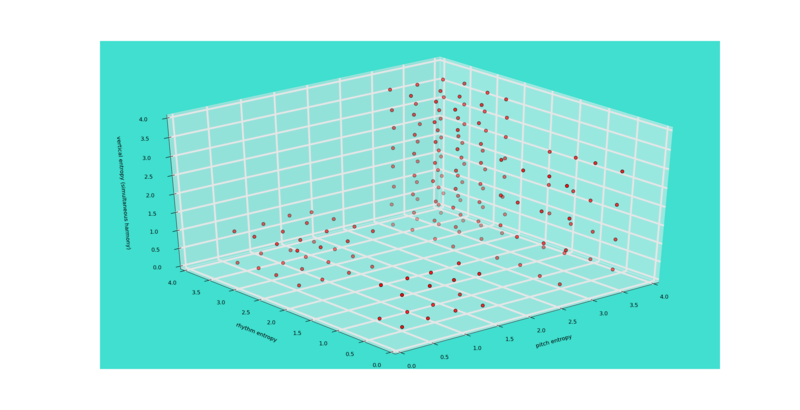
Regions can overlap each other and one thing this makes possible is the ability specify density gradients.
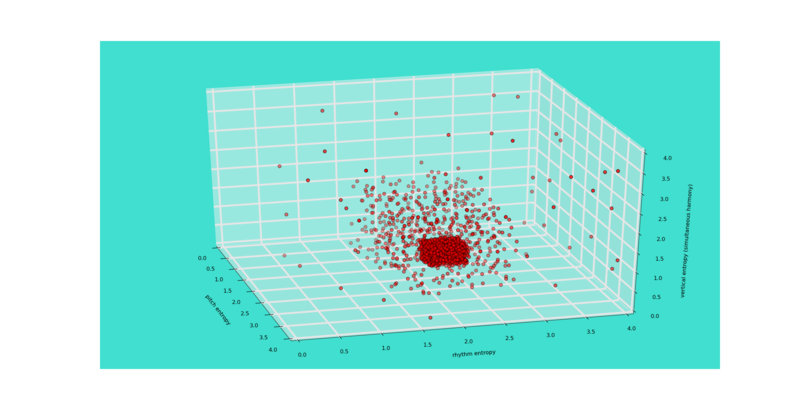
And thinking about overlapping regions, gave me an idea on how to handle impossible substrates that can never-the-less influence the transformation of possible substrates. Impossible substrates are those that the counter-factuals deem unnatural. However, per Construction Theory, impossible substrates may be transformed into possible substrates or influence other possible substrate transformations. These impossible substrates cannot inhabit the natural world, they reside in what I'm calling the supernatural realm or region. My syntax provides an easy way to add a region, the supernatural region, where the normal laws of nature are suspended, this is where impossible substrates that have the power to influence possible substrates can reside. I call these impossible substrates that can influence the transformation of possible substrates "angel substrates".
Here's plot of a single dense region of possible substrates engulfed by a supernatural region populated by angel substrates.

And after thinking about all this some more, I'm liking the idea of having each region have the ability to define their own counter-factuals. This should not only make it possible to have clear laws for the natural vs supernatural but allow regions for different chords and intros and turnarounds, etc..
Four regions in space, each with different densities would be defined like:
lentropy=[
[ [.5, 2., 10, 20, cry, 'r'], [.5, 1., 10, 20, cry, 'r'], [0., 1., 3, 20, cry, 'r'] ],
[ [.5, 2., 5, 20, cry, ''], [2.5,4., 10, 20, cry, 'r'], [0., 1., 2, 20, cry, 'r'] ],
[ [3., 4., 2, 20, cry, 'r'], [.5, 2., 2, 20, cry, 'r'], [0., 3., 2, 20, cry, 'r'] ],
[ [3., 4., 20, 30, cry, 'r'], [2.5, 4., 20, 20, cry, 'r'], [0., 4., 15, 20, cry, 'r'] ]
]
Each line defines a different region. Each list on a line is for pitch, rhythm, and vertical entropy.
Each list defines min entropy, max entropy, min density, max density, crystal factor, and shape.
The above would produce a space similar (I think I changed a few variables a bit) to this: (At this point I'm calling a uniform random number generator to find objects to attempt to fill the regions, eventually I'll try to fill the regions with licks.)

And by changing the shape variable, wedges and triangular shapes can be specified. I added this mostly to accomidate sweet and sour possible profiles, I'll add other shapes if there seems to be a need for them.

By adjusting the density and crystal factor more or less regular lattice spacing can be specified. I'm not sure how useful this is, it's just something that came to mind as I was trying to think about the problem of selecting licks (or random anything) to fit a volume and how one might go about doing that.)
Pretty regular.

And more regular.

Regions can overlap each other and one thing this makes possible is the ability specify density gradients.

And thinking about overlapping regions, gave me an idea on how to handle impossible substrates that can never-the-less influence the transformation of possible substrates. Impossible substrates are those that the counter-factuals deem unnatural. However, per Construction Theory, impossible substrates may be transformed into possible substrates or influence other possible substrate transformations. These impossible substrates cannot inhabit the natural world, they reside in what I'm calling the supernatural realm or region. My syntax provides an easy way to add a region, the supernatural region, where the normal laws of nature are suspended, this is where impossible substrates that have the power to influence possible substrates can reside. I call these impossible substrates that can influence the transformation of possible substrates "angel substrates".
Here's plot of a single dense region of possible substrates engulfed by a supernatural region populated by angel substrates.

And after thinking about all this some more, I'm liking the idea of having each region have the ability to define their own counter-factuals. This should not only make it possible to have clear laws for the natural vs supernatural but allow regions for different chords and intros and turnarounds, etc..